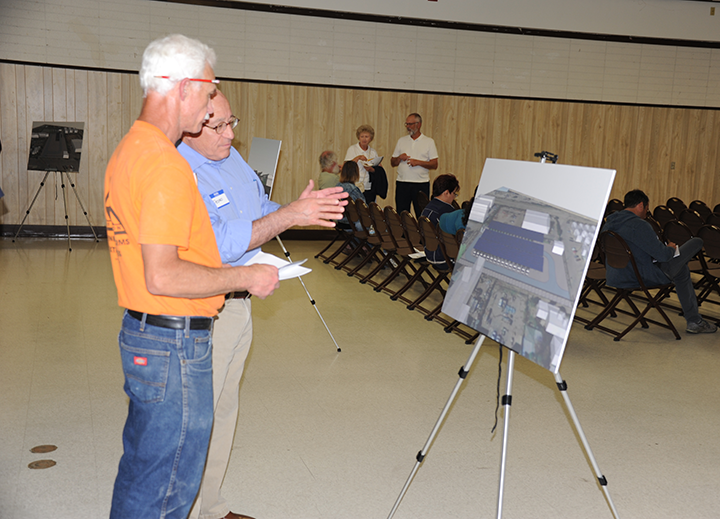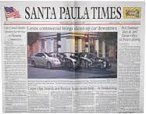Held at the Community Center, the meeting attracted residents and those with an eye on the environment, as well as representatives of ZGlobal/Western Grid Development, LLC, a power engineering and energy company based in Folsom.
Pedro Nava, the company’s public relations consultant, led the session explaining the proposed project.
The project requires a Conditional Use Permit, which means it must be approved by the Planning Commission — presented with a concept review in October — and the City Council.
The 5 MW battery system — immediately adjacent to the SoCal Edison Wakefield substation — would be charged by solar panels located at the project site. The project presented to the Planning Commission included 20 energy storage modules up to 53-feet long, constructed away from 13th Street. The secured property would be fenced and landscaped; there would be an office for a scant crew as needed.
If constructed the project — described by applicants as green energy — is eligible to fulfill Edison’s local capacity requirements, as would the proposed, and highly controversial, Calpine Mission Rock Road Energy Project.
Nava said “Santa Paula has always demonstrated a very active” involvement in community. “You have something special in Santa Paula,” including “a long rich history.”
Residents’ “level of engagement is unrivaled…because of that the city looks and feels the way it does,” including the lack of overhead wiring on Main Street a “conscious decision” that showed “those in the past were looking towards the future.”
Z-Global, he noted, has a “long history also of working with the community and making contributions.”
Ziad Alaywan of ZGlobal-Western Grid Development spoke about why the project is proposed to be located in the city noting the 1.5-acre parcel’s proximity to the electrical substation.
“We did a 30 megawatt about five times larger than this, it’s been operating for about six months,” in El Centro, a facility that Alaywan said is highly efficient.
Purchasing the property from “a friend of a friend” he noted was “A good deal for both of us.”
Alaywan, an electrical engineer, said his company employs 50 people at two locations.
Nava explained the workings of the facility as well as “an over-generation of solar” that caused the state to request that utilities invest $2 billion in battery storage technology.
“We’re not burning petroleum,” using natural gas or relying on nuclear power but rather solar generated power that is stored in batteries for use as needed.
Connections to the Wakefield substation from the 53-foot-long containers would be underground and after construction was completed there would “very little traffic” at the site.
“It’s another source of local energy at no cost to the city and city taxpayers,” and Nava said local contractors and labor would be used.
The facility would not generate pollution, noise or use large amounts of water, unlike other generators such as peaker plants.
Samsung SDI produces the prismatic cell batteries and each container would have its own state of the art Novec fire suppression system.
The city has the CEQA document available for a 30-day review and comment period.
During the question and answer period a variety of questions were asked including heat generation — “very minimal” was the answer — as well as the anticipated lifespan of the facility, estimated by a Samsung representative at about 20 years.
In addition, a Samsung representative, said the “highly engineered, specialized batteries” would be taken back by Samsung to be recycled or repurposed for other applications.
There is an “incredible difference between the batteries in a mobile phone and these,” with the batteries used for the project at the “other end of the spectrum” from those Lithium batteries used in cell phones. Such batteries including those for Hoverboards have been in the news because of fires.
The batteries to be used in the project are not sealed in an aluminum pouch common to consumer uses, but rather are a “laser sealed aluminum can” that becomes a useless “brick” in the case of problems.
Ken Chapman asked if the company would be receiving subsidies from the state, noting, “It’s their program…”
Alaywan said, “There is no subsidy, it is completely private.”
The company’s revenue, he noted is for standby power, ready to fulfill emergency needs or when extra power is needed.
When power is needed, “Then we have to perform and produce to the distribution center,” which pushes back energy “coming to Santa Paula from someplace else.”
“Thank you for providing a clean, green energy project in Santa Paula,” said Laura Flores Espinosa, the city’s former vice mayor, who said the agreement should note that Santa Paula should be supplied first when needed before energy is sent “to Montecito.”
She said the barbed wire topping on the fence planned for the facility should be hidden.
“We have a lot of pride in our community,” and Espinosa suggested, “To make it more esthetically pleasing perhaps you would consider a public art project. This is a new game here, maybe we should acknowledge that, connect that with the pride of our community.”
She also urged that any contract include a caveat for facility removal noting that such a dismantling clause would avoid the issue of blight common to Latino communities “left with the cleanup…”
Under questioning company representatives noted the value of the property improvements would be up to $20 million that would bring more revenue to the city in property taxes and that the city should benefit from the purchase of the equipment.
Others asked for details on fire danger and the Novec system as well as a detailed description of the system.
The risk at the site would be from high voltage.
Alaywan said if built, the Santa Paula facility would be the sixth in Southern California.
Another question centered on finances: “We’ve done the math,” said Alaywan. “The cost for this is a fixed cost,” with low overhead, “no human cost. You can predetermine the cost for the next 20 years, you don’t have variable costs that fluctuate.”
One attendee suggested a representative of SoCal Edison should have been present and asked if there has been incidents at the El Centro facility.
There have been some power efficiency issues said Alaywan.
Other company representatives who answered questions or offered comment included Matthew Nelson and Jamie Nichole Nagel. Chris Stabenfeldt, AICP of ECORP is the lead environmental manager for the project.



